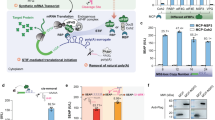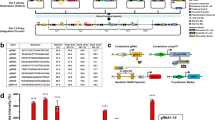Abstract
Gene therapy was originally conceived as a medical intervention to replace or correct defective genes in patients with inherited disorders. However, it may have much broader potential as an alternative delivery platform for protein therapeutics, such as cytokines, hormones, antibodies and novel engineered proteins. One key technical barrier to the widespread implementation of this form of therapy is the need for precise control over the level of protein production. A suitable system for pharmacologic control of therapeutic gene expression would permit precise titration of gene product dosage, intermittent or pulsatile treatment, and ready termination of therapy by withdrawal of the activating drug. We set out to design such a system with the following properties: (1) low baseline expression and high induction ratio; (2) positive control by an orally bioavailable small–molecule drug; (3) reduced potential for immune recognition through the exclusive use of human proteins; and (4) modularity to allow the independent optimization of each component using the tools of protein engineering. We report here the properties of this system and demonstrate its use to control circulating levels of human growth hormone in mice implanted with engineered human cells.
This is a preview of subscription content, access via your institution
Access options
Subscribe to this journal
Receive 12 print issues and online access
$209.00 per year
only $17.42 per issue
Buy this article
- Purchase on Springer Link
- Instant access to full article PDF
Prices may be subject to local taxes which are calculated during checkout
Similar content being viewed by others
References
Gossen, M., Bonin, A. & Bujard, H. Control of gene activity in higher eukaryotic cells by prokaryotic regulatory elements. Trends Biol. Sci. 18, 471–475 (1993).
Spencer, D.M. Creating conditional mutants in mammals. Trends Genet. 12, 181–187 (1996).
Ptashne, M. How eukaryotic transcriptional activators work. Nature 335, 683–689 (1988).
Brent, R. & Ptashne, M. A eukaryotic transcriptional activator bearing the DNA specificity of a prokaryotic repressor. Cell 43, 729–736 (1985).
Hope, I.A. & Struhl, K. Functional dissection of a eukaryotic transcriptional activator protein, GCN4 of yeast. Cell 46, 885–894 (1986).
Fields, S. & Song, O.-K. A novel genetic system to detect protein-protein interactions. Nature 340, 245–246 (1989).
Spencer, D.M., Wandless, T.J., Schreiber, S.L. & Crabtree, G.R. Controlling signal transduction with synthetic ligands. Science 262, 1019–1024 (1993).
Austin, D.J., Crabtree, G.R. & Schreiber, S.L. Proximity versus allostery: The role of regulated protein dimerization in biology. Chem. Biol. 1, 131–136 (1994).
Pruschy, M.N. et a Mechanistic studies of a signaling pathway activated by the organic dimerizer FK1012. Chem. Biol. 1, 163–172 (1994).
Spencer, D.M., Graef, I., Austin, D.J., Schreiber, S.L. & Crabtree, G.R. A general strategy for producing conditional alleles of Src-like tyrosine kinases. Proc. Natl. Acad. Sci. USA 92, 9805–9809 (1995).
Holsinger, L.J., Spencer, D.M., Austin, D.J., Schreiber, S.L. & Crabtree, G.R. Signal transduction in T lymphocytes using a conditional allele of Sos. Proc. Natl Acad. Sci. USA 92, 9810–9814 (1995).
Belshaw, P.J., Ho, S.N., Crabtree, G.R. & Schreiber, S.L. Controlling protein association and subcellular localization with a synthetic ligand that induces het-erodimerization of proteins. Proc. Natl. Acad. Sci. USA 93, 4604–4607 (1996).
Ho, S.N., Biggar, S.R., Spencer, D.M., Schreiber, S.L. & Crabtree, G.R. Controlling transcription with synthetic ligands. Nature (in the press).
Bierer, B.E. et al. Two distinct signal transmission pathways in T lymphocytes are inhibited by complexes formed between an immunophilin and either FK506 or rapamycin. Proc. Natl. Acad. Sci. USA 87, 9231–9235 (1990).
Brown, E.J. et al. A mammalian protein targeted by G1-arresting rapamycin-receptor complex. Nature 369, 756–758 (1994).
Chiu, M.L., Katz, H. & Berlin, V. RAPT1, a mammalian homolog of yeast Tor, interacts with the FKBP12/rapamycin complex. Proc. Natl. Acad. Sci. USA 91, 12574–12578 (1994).
Sabatini, D.M., Erdjument-Bromage, H., Lui, M., Tempst, P. & Snyder, S.H. RAFT1: A mammalian protein that binds to FKBP12 in a rapamycin-dependent fashion and is homologous to yeast TORs. Cell 78, 35–43 (1994).
Sabers, C.J. et al. Isolation of a protein target of the FKBP12-rapamycin complex in mammalian cells. J. Biol. Chem. 270, 815–822 (1995).
Stan, R. et al. Interaction between FKBP12-rapamycin and TOR involves a conserved serine residue. J. Biol. Chem. 269, 32037–32030 (1994).
Kahan, B., Chang, J. & Sehgal, S. Preclinical evaluation of a new potent im-munosuppressive agent, rapamycin. Transplantation 52, 185–191 (1991).
Kay, J., Kromwel, L., Doe, S. & Denyer, M. Inhibition of T and B lymphocyte proliferation by rapamycin. Immunology 72, 544–549 (1991).
Stepkowski, S., Chen, H., Daloze, P. & Kahan, B., mycin, apotent immuno-suppressive drug for vascularized heart, kidney, and small bowel transplantation ir- the rat. Transplantation 51, 22–26 (1991).
Pomerantz, J.L., Sharp, P.A. & CO.Structure-based design of transcription factors. Science 267, 93–96 (1995).
Schmitz, M.L. & Baeurle, P.A. The p65 subunit is responsible for the strong transcription activating potential of NF-KB. EMBO J. 10, 3805–3817 (1991).
Chen, J., Zheng, X.F., Brown, E.J. & Schreiber, S.L. Identification of an 11-kDa FKBP12-rapamycin-binding domain within the 289-kDa FKBP12-rapamycin-associated protein and characterization of a critical serine residue. Proc. Natl. Acad. Sci. USA 92, 4947–4951 (1995).
Heartlein, M.W. et al. Long-term production and delivery of human growth hormone. Proc. Natl. Acad. Sci. USA 91, 10967–10971 (1994).
Riddell, S.R. et al. T-cell mediated rejection of gene-modified HIV-specific cyto-toxic T lymphocytes in HIV-infected patients. Nature Med. 2, 216–223 (1996).
Stern, L.J. & Wiley, D.C. Antigenic peptide binding by class I and class II histo-compatibility proteins. Structure 2, 245–251 (1994).
Luengo, J.I. et al. Structure-activity studies of rapamycin analogs: Evidence that the C-7 methoxy is part of the effector domain and positioned at the FKBP12/FRAP interface. Chem. Biol 2, 471–481 (1995).
Belshaw, P.J., Schoepfer, J., Liu, K., Morrison, K. & Schreiber, S.L. Rational design of orthogonal receptor-ligand combinations. Angew. Chem. Int. Ed. Eng. 34, 2129–2132 (1995).
Choi, J., Chen, J., Schreiber, S.L. & Clardy, J. Structure of the FKBP12-rapamycin complex interacting with the binding domain of human FRAP. Science 273, 239–242 (1996).
Attar, R.M. & Gilman, M.Z. Expression cloning of a novel zinc-finger protein that binds to the c-fos serum response element. Mol. Cell. Biol. 12, 2432–2443 (1992).
Standaert, R.F., Galat, A., Verdine, G.L. & Schreiber, S.L. Molecular cloning and overexpression of the human FK506-binding protein FKBP. Nature 346, 671–674 (1990).
Boshart, M. et al A very strong enhancer is located upstream of an immediate early gene of human cytomegalovirus. Cell 41, 521–530 (1985).
Siebenlist, U. et al Promoter region of interleukin-2 gene undergoes chro-matin structure changes and confers inducibility on chloramphenicol acetyl-transferase gene during activation of T cells. Mol. Cell Biol 6, 3042–3049 (1986).
Selden, R.F., Burke-Howie, K., Rowe, M.E., Goodman, H.M. & Moore, D.D. Human growth hormone as a reporter gene in regulation studies employing transient gene expression. Mol Cell Biol. 6, 3173–3179 (1986).
Morgenstern, J.P. & Land, H. Advanced mammalian gene transfer: High titre retroviral vectors with multiple drug selection markers and a complementary helper-free packaging cell line. Nucleic Acids Res. 18, 3587–3596 (1990).
Muller, A.J. et al. BCR first exon sequences specifically activate BCR/ABL tyrosine kinase oncogene of Philadelphia chromosome-positive human leukemias. Mol Cell Biol 11, 1785–1792 (1991).
Pear, W.S., Nolan, G.P., Scott, M.L. & Baltimore, D. Production of high-titer helper-free retroviruses by transient transfection. Proc. Natl. Acad. Sci. USA 90, 8392–8396 (1993).
Author information
Authors and Affiliations
Rights and permissions
About this article
Cite this article
Rivera, V., Clackson, T., Natesan, S. et al. A humanized system for pharmacologic control of gene expression. Nat Med 2, 1028–1032 (1996). https://doi.org/10.1038/nm0996-1028
Received:
Accepted:
Issue Date:
DOI: https://doi.org/10.1038/nm0996-1028
This article is cited by
-
A programmable protease-based protein secretion platform for therapeutic applications
Nature Chemical Biology (2024)
-
A simeprevir-inducible molecular switch for the control of cell and gene therapies
Nature Communications (2023)
-
Target-dependent RNA polymerase as universal platform for gene expression control in response to intracellular molecules
Nature Communications (2023)
-
A single-component, light-assisted uncaging switch for endoproteolytic release
Nature Chemical Biology (2023)
-
Designer installation of a substrate recruitment domain to tailor enzyme specificity
Nature Chemical Biology (2023)



